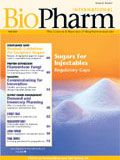Final Word: Creative Solutions Can Ensure Pandemic Flu Preparedness
Certain areas of the vaccine market appear to be in vogue again, revitalized by blockbusters such as Prevnar, the pneumococcal pneumonia vaccine that reaped $1.5 billion in sales last year, and the human papilloma virus vaccines, which are projected to reach $4 billion per year.
Certain areas of the vaccine market appear to be in vogue again, revitalized by blockbusters such as Prevnar, the pneumococcal pneumonia vaccine that reaped $1.5 billion in sales last year, and the human papilloma virus vaccines, which are projected to reach $4 billion per year.

Nipon Das, MD
Unfortunately, this glory has not reached influenza vaccines. Last season's flu vaccine shortage and the current challenges in preparing for a flu pandemic reveal the untenable nature of our flu vaccine supply chain.
The major cost driver of vaccines is not R&D or sales and marketing, but manufacturing. The price of a new vaccine manufacturing facility can easily reach $300 to $500 million—a cost not easily justifiable when flu vaccines are reimbursed at $20 a patient. In this situation, we need creative approaches to find new solutions.
Because market forces have failed to provide sufficient incentives to flu vaccine manufacturers, long-term solutions require public sector support. While governments are addressing the demand side of the equation through advanced purchase agreements, the Economic Alliance of Greater Baltimore—a public-private economic and business development group—is addressing the cost side of the equation through several novel, public-private business models that lower costs and risks to the manufacturer.
LEASE AGREEMENTS REDUCE RISK AND COSTS
Advanced purchase agreements for vaccines provide a good business incentive, but only for the short term. Leases, by contrast, reduce long-term investment exposure. We have learned from the public financing and real estate industry that combining access to cheap capital and "condo-style" leasing arrangements can lower the cost of production without relying on government subsidies or tax incentives that may not be sustainable. Many case studies show this method has been effective at jump-starting industries like waste management and hotels.1,2
MODULAR AND COOPERATIVE PRODUCTION
Vaccine manufacturers can learn from Japanese car manufacturers. While several American auto manufacturers built single-model or single-platform plants for SUVs—which are now in the doldrums—several Japanese companies built modular plants that produce various car models for different markets. These plants can respond quickly to market dynamics, scaling up production of popular products and scaling back waning ones.3
Another lesson can be applied from the "coopetition" strategy that Chrysler, Hyundai, and Mitsubishi are adopting to jointly build high-efficiency engine blocks at a single facility for economy cars.4 This cooperation allows these companies to surmount high, fixed costs to enter a fragmented market for low-profit cars.5
While the vaccine industry continues to heat up, there is much work to be done to bridge the relative gap between the high cost of production and commodity pricing. Organizations—both public and private—need to keep an open mind to all solutions to ensure that the vaccine supply chain does not continue to falter.
Nipon Das,MD, is the executive vice-president of the Economic Alliance of Greater Baltimore, 111 South Calvert St., Suite 2220, Baltimore, MD 21202, 410.637.4102, ndas@greaterbaltimore.org
REFERENCES
1. US Environmental Protection Agency. Clean Water State Revolving Fund. Available at: www.epa.gov/owm/cwfinance/cwsrf/.
2. Maryland Economic Development Corp. Cambridge Hyatt in Complete Project List. Date "Since June 1999." Available at: www.medco-corp.com/content/completeprojectlist.cfm.
3. Boudette NE. Shifting Gears. Wall Street Journal 2006 April 11:A1.
4. Flexible automotive Automation Contract Awarded. Manufacturing Talk 2005 Feb 28. Available at: www.manufacturingtalk.com/news/mib/mib138.html.
5. ISEEK. Future work: Carmakers' big idea: Think small. 2006 Feb 5. Available at: www.iseek.org/sv/37.jsp?fwa=fw/fw5961.jsp&id=5961.

VERAXA and Voyager to Create Combined Business for Advancing Pipeline of Next-Gen Cancer Therapies
April 23rd 2025The proposed business combination would create a publicly traded, clinical-stage biopharmaceutical company that will focus on developing a pipeline of next-generation cancer therapies.
Thermo Fisher Opens Advanced Therapies Collaboration Center in California
April 18th 2025The 6000-square-foot facility will provide cell therapy developers the support they need to transition to CGMP manufacturing, and an expanded footprint of the new center is expected to open in Philadelphia later in 2025.